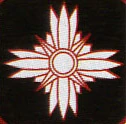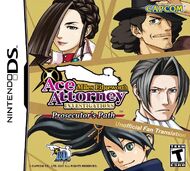No edit summary |
mNo edit summary |
||
| (24 intermediate revisions by 12 users not shown) | |||
| Line 1: | Line 1: | ||
| + | {{Prosecutor'sPath}} |
||
| − | [[File:Prosbadge icon big.png|thumb|68px|left]] |
||
| + | {{EvidenceInfo |
||
| − | A Prosecutor's Badge is a mode of identification in use solely by prosecutors. Every active Prosecutor must carry one, and it is the equivalent of a defense attorney's [[Attorney's Badge]]. |
||
| + | |image = Prosbadge icon big.png |
||
| + | |description = Proof of [[Miles Edgeworth|my]] profession. However, I prefer to keep it in my pocket. |
||
| + | |type = Other |
||
| + | |obtained = [[Miles Edgeworth|Personal possession]]. |
||
| + | |episode = ''[[Turnabout Visitor]]'' <br> ''[[Turnabout Airlines]]'' <br> ''[[The Kidnapped Turnabout]]'' <br> ''[[Turnabout Reminiscence]]'' <br> ''[[Turnabout Ablaze]]'' <br> ''[[Turnabout Target]]'' <br> ''[[The Imprisoned Turnabout]]'' <br> ''[[The Inherited Turnabout]]'' <br> ''[[The Forgotten Turnabout]]'' |
||
| + | }} |
||
| + | A '''prosecutor's badge''' is an object used as identification for prosecutors. It depicts a blazing sun looming over winter frost, which is allegedly designed to portray the severity of the punishment system. |
||
| + | Every prosecutor carries a badge, though many don't wear it openly in the way defense attorneys do. Among those who do wear their badges are Chief Prosecutor [[Blaise Debeste]] and his son [[Sebastian Debeste|Sebastian]], as well as the prosecutor in charge of the first [[UR-1 Incident]] trial. [[Manfred von Karma]] believed in keeping his badge in his pocket at all times and taught [[Miles Edgeworth]], and most other district prosecutors, to do the same. |
||
| − | ==List Of Prosecutors== |
||
| − | These prosecutors carry a badge, even though these badges are not worn on a prosecutor's lapel like an attorney's badge. |
||
| + | ==Other uses of design== |
||
| − | [[Miles Edgeworth]] |
||
| + | [[File:Prosecutorbadgescan.jpg|thumb|left|Design on the chief of police office floor.]] |
||
| + | This badge design [[Dai Gyakuten Saiban: Naruhodō Ryūnosuke no Bōken|was also used]] by [[Japan]]ese prosecutors during the [[Wikipedia:Meiji period|Meiji period]], albeit on an armband rather than as a lapel pin. Additionally, the design used for the prosecutor's badge can be seen on the floor design of the [[Chief's office|office of the chief of police]]. |
||
| + | {{EvidenceNavBoxAAI|c}} |
||
| − | [[Manfred von Karma]] |
||
| + | {{EvidenceNavBoxGK2|c}} |
||
| − | |||
| + | [[Category:Evidence]] |
||
| − | [[Franziska von Karma]] |
||
| + | [[Category:Ace Attorney Investigations: Miles Edgeworth]] |
||
| − | |||
| + | [[Category:Gyakuten Kenji 2]] |
||
| − | [[Lana Skye]] |
||
| − | |||
| − | [[Neil Marshall]] |
||
| − | |||
| − | [[Winston Payne]] |
||
| − | |||
| − | [[Godot]] |
||
| − | |||
| − | [[Jacques Portsman]] |
||
| − | |||
| − | [[Faraday (prosecutor)]] |
||
| − | |||
| − | [[Klavier Gavin]] |
||
Revision as of 17:55, 14 December 2018
| This article contains information from the unofficial English translation patch for Gyakuten Kenji 2. | |
|---|---|
|
Owing to the lack of an official translation of the Japan-only Gyakuten Kenji 2, the information and names in this article come from the unofficial English translation patch known as Ace Attorney Investigations: Miles Edgeworth: Prosecutor's Path. More information on this can be found here. If you have personal experience with the item of media in question, you can help the Ace Attorney Wiki by improving on this article. Please heed the manual of style when adding information. | |
A prosecutor's badge is an object used as identification for prosecutors. It depicts a blazing sun looming over winter frost, which is allegedly designed to portray the severity of the punishment system.
Every prosecutor carries a badge, though many don't wear it openly in the way defense attorneys do. Among those who do wear their badges are Chief Prosecutor Blaise Debeste and his son Sebastian, as well as the prosecutor in charge of the first UR-1 Incident trial. Manfred von Karma believed in keeping his badge in his pocket at all times and taught Miles Edgeworth, and most other district prosecutors, to do the same.
Other uses of design

Design on the chief of police office floor.
This badge design was also used by Japanese prosecutors during the Meiji period, albeit on an armband rather than as a lapel pin. Additionally, the design used for the prosecutor's badge can be seen on the floor design of the office of the chief of police.

